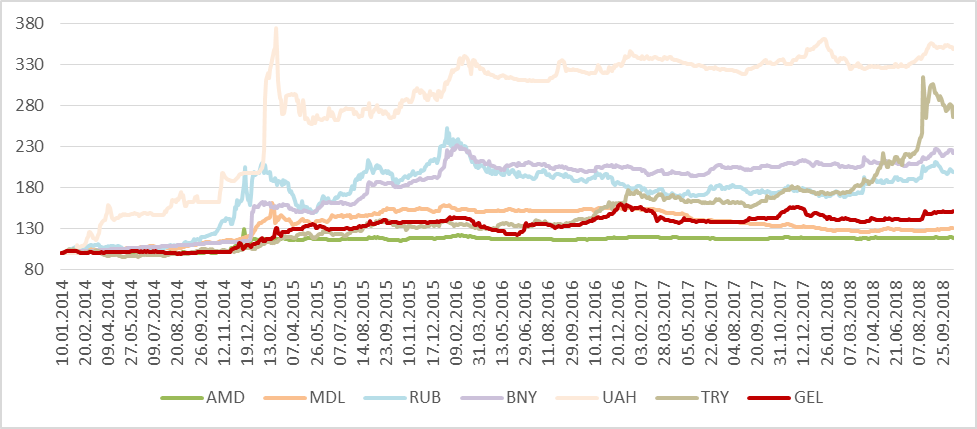Verdict:
FactCheck concludes that Irakli Kobakhidze’s statement is
HALF TRUE.
Resume: The last episode of the sharp depreciation of GEL against USD happened in August 2018 when GEL depreciated by nearly 8% from 2.4 to 2.6. Irakli Kobakhidze compares the GEL to USD exchange rate to Russia, Armenia, Azerbaijan, Belarus, Ukraine and Moldova. Of these countries’ currencies, only BYN and TRY have depreciated more than GEL in the period of August-October 2018. Azerbaijan has a fixed currency exchange rate and it experienced no changes in 2018. Therefore, Mr Kobakhidze could not compare GEL to AZN.
In order to verify Irakli Kobakhidze’s statement, it is more appropriate to begin with the depreciation which started in 2014. GEL started to depreciate against USD and EUR from the third quarter of 2014 and eventually depreciated by nearly 55%-60%. This period coincided with the growth of the USD index, the fall in oil prices and multiple crises hitting the region, all of which affected not only GEL but other currencies, too. However, even in these circumstances, both AMD and MDL have depreciated less against USD than GEL.
Of note is that certain actions or inactions of the Government of Georgia (low economic growth rate, imposition of a stricter visa regime with a number of countries, unwitting
[1] reforms, unequal spending of state finances, etc.),
[2] together with external factors, have contributed to the GEL depreciation which started in 2014. Without taking the full context of the situation into account, tying the GEL exchange rate only to domestic or external factors gives just half of the reality.
Analysis
On 25 September 2018, the Speaker of the Parliament of Georgia, Irakli Kobakhidze, on air on the talk show,
Reaktsia,
stated: “The GEL depreciation has had objective grounds. The currencies of all of the countries around us have depreciated. This was in Azerbaijan where the depreciation was higher than in Georgia, this was in Turkey where the depreciation was much higher than in Georgia and this was in Armenia where the depreciation was slightly less than in Georgia. These examples are also in Belarus, Ukraine, Moldova and Russia. In all of these countries, their currencies have depreciated more than our currency.”
One of the most pressing issues in Georgia in the last years is the GEL depreciation (devaluation) against USD and EUR. The GEL exchange rate started to depreciate in November 2014 and has depreciated by nearly 55%.
In the period of August-October 2018, only BNY and TRY depreciated more against USD than GEL. Of note is that Azerbaijan maintained a fixed currency exchange rate throughout 2018. Therefore, Irakli Kobakhidze could not compare GEL to AZN based on 2018 data. Mr Kobakhidze’s statement is more relevant if we take the exchange rates of the national currencies from 2014 until the time of his statement. However, even in this case, MDL has depreciated less as compared to GEL.
Table 1: Depreciation Figures of Currencies of Different Countries, 2014-2018
|
As Compared to 2014 |
As Compared to August 2018 |
| GEL |
55% |
8% |
| TRY |
190% |
22% |
| AMD |
14% |
0.62% |
| AZN |
142% |
N/A |
| RUB |
65% |
6% |
| BNY |
117% |
8.70% |
| UAH |
137% |
4% |
| MDL |
14% |
1.2% |
Source: Websites of the national banks of these countries
Graph 1 shows the depreciation of the national currencies (%) against USD where the exchange rates as of 1 January 2014 are taken as a base. Therefore, currencies which depreciated more than GEL in that particular period will be visually higher than GEL whilst currencies which depreciated less than GEL will end up lower than GEL. Consequently, MDL and AMD are lower than GEL.
Graph 1: Aforementioned Countries’ Currency Exchange Dynamic (%) against USD
 Source: National banks of the respective countries
Source: National banks of the respective countries
GEL has a floating exchange rate and the GEL:USD supply and demand ratio on the currency market determines the GEL exchange rate at a given point. Naturally, multiple factors simultaneously affect supply and demand which can hypothetically be divided into internal and external factors. Often, there are political motives for associating the GEL exchange rate to only internal or external factors. In order to avoid speculations, however, it is necessary to analyse the full picture. Therefore, certain actions or inactions of the Government of Georgia (low economic growth rate, imposition of a stricter visa regime for a number of countries, flawed reforms, unequal spending of state finances, etc. See
link 1;
link 2) have had their fair share of contribution in GEL depreciation which started in 2014. Without taking the full context into account, blaming the GEL exchange rate on internal or external factors alone gives only half of the reality. Therefore, considering the context, Irakli Kobakhidze does not describe the entire picture.
In regard to regional problems, the 2014-2018 period was quite difficult and full of political and economic crises. Of note is the attempted coup d’état in Turkey and the resulting deterioration of relations with the West, the Russia-Ukraine crisis, the Syria crisis, etc. It is evident that all of these have negatively affected the economic conjecture and the strength of the national currencies both in Georgia and in the aforementioned countries.
Further, the nearly halved oil prices and the growth of the USD index, which are interrelated events to some extent, have dealt a blow to the world’s economic conjecture. The
growth of the USD index has resulted in a depreciation of not only GEL but almost every world currency’s exchange rate against USD.
[1] For instance, the idea to separate the supervisory function from the National Bank, the imposition of a stricter visa policy, etc., in 2016.
[2] For reasons for the depreciation in the last months, see:
Why Did GEL Depreciate in the Last Period?
 Source: National banks of the respective countries
GEL has a floating exchange rate and the GEL:USD supply and demand ratio on the currency market determines the GEL exchange rate at a given point. Naturally, multiple factors simultaneously affect supply and demand which can hypothetically be divided into internal and external factors. Often, there are political motives for associating the GEL exchange rate to only internal or external factors. In order to avoid speculations, however, it is necessary to analyse the full picture. Therefore, certain actions or inactions of the Government of Georgia (low economic growth rate, imposition of a stricter visa regime for a number of countries, flawed reforms, unequal spending of state finances, etc. See link 1; link 2) have had their fair share of contribution in GEL depreciation which started in 2014. Without taking the full context into account, blaming the GEL exchange rate on internal or external factors alone gives only half of the reality. Therefore, considering the context, Irakli Kobakhidze does not describe the entire picture.
In regard to regional problems, the 2014-2018 period was quite difficult and full of political and economic crises. Of note is the attempted coup d’état in Turkey and the resulting deterioration of relations with the West, the Russia-Ukraine crisis, the Syria crisis, etc. It is evident that all of these have negatively affected the economic conjecture and the strength of the national currencies both in Georgia and in the aforementioned countries.
Further, the nearly halved oil prices and the growth of the USD index, which are interrelated events to some extent, have dealt a blow to the world’s economic conjecture. The growth of the USD index has resulted in a depreciation of not only GEL but almost every world currency’s exchange rate against USD.
[1] For instance, the idea to separate the supervisory function from the National Bank, the imposition of a stricter visa policy, etc., in 2016.
[2] For reasons for the depreciation in the last months, see: Why Did GEL Depreciate in the Last Period?
Source: National banks of the respective countries
GEL has a floating exchange rate and the GEL:USD supply and demand ratio on the currency market determines the GEL exchange rate at a given point. Naturally, multiple factors simultaneously affect supply and demand which can hypothetically be divided into internal and external factors. Often, there are political motives for associating the GEL exchange rate to only internal or external factors. In order to avoid speculations, however, it is necessary to analyse the full picture. Therefore, certain actions or inactions of the Government of Georgia (low economic growth rate, imposition of a stricter visa regime for a number of countries, flawed reforms, unequal spending of state finances, etc. See link 1; link 2) have had their fair share of contribution in GEL depreciation which started in 2014. Without taking the full context into account, blaming the GEL exchange rate on internal or external factors alone gives only half of the reality. Therefore, considering the context, Irakli Kobakhidze does not describe the entire picture.
In regard to regional problems, the 2014-2018 period was quite difficult and full of political and economic crises. Of note is the attempted coup d’état in Turkey and the resulting deterioration of relations with the West, the Russia-Ukraine crisis, the Syria crisis, etc. It is evident that all of these have negatively affected the economic conjecture and the strength of the national currencies both in Georgia and in the aforementioned countries.
Further, the nearly halved oil prices and the growth of the USD index, which are interrelated events to some extent, have dealt a blow to the world’s economic conjecture. The growth of the USD index has resulted in a depreciation of not only GEL but almost every world currency’s exchange rate against USD.
[1] For instance, the idea to separate the supervisory function from the National Bank, the imposition of a stricter visa policy, etc., in 2016.
[2] For reasons for the depreciation in the last months, see: Why Did GEL Depreciate in the Last Period?
 Source: National banks of the respective countries
GEL has a floating exchange rate and the GEL:USD supply and demand ratio on the currency market determines the GEL exchange rate at a given point. Naturally, multiple factors simultaneously affect supply and demand which can hypothetically be divided into internal and external factors. Often, there are political motives for associating the GEL exchange rate to only internal or external factors. In order to avoid speculations, however, it is necessary to analyse the full picture. Therefore, certain actions or inactions of the Government of Georgia (low economic growth rate, imposition of a stricter visa regime for a number of countries, flawed reforms, unequal spending of state finances, etc. See link 1; link 2) have had their fair share of contribution in GEL depreciation which started in 2014. Without taking the full context into account, blaming the GEL exchange rate on internal or external factors alone gives only half of the reality. Therefore, considering the context, Irakli Kobakhidze does not describe the entire picture.
In regard to regional problems, the 2014-2018 period was quite difficult and full of political and economic crises. Of note is the attempted coup d’état in Turkey and the resulting deterioration of relations with the West, the Russia-Ukraine crisis, the Syria crisis, etc. It is evident that all of these have negatively affected the economic conjecture and the strength of the national currencies both in Georgia and in the aforementioned countries.
Further, the nearly halved oil prices and the growth of the USD index, which are interrelated events to some extent, have dealt a blow to the world’s economic conjecture. The growth of the USD index has resulted in a depreciation of not only GEL but almost every world currency’s exchange rate against USD.
[1] For instance, the idea to separate the supervisory function from the National Bank, the imposition of a stricter visa policy, etc., in 2016.
[2] For reasons for the depreciation in the last months, see: Why Did GEL Depreciate in the Last Period?
Source: National banks of the respective countries
GEL has a floating exchange rate and the GEL:USD supply and demand ratio on the currency market determines the GEL exchange rate at a given point. Naturally, multiple factors simultaneously affect supply and demand which can hypothetically be divided into internal and external factors. Often, there are political motives for associating the GEL exchange rate to only internal or external factors. In order to avoid speculations, however, it is necessary to analyse the full picture. Therefore, certain actions or inactions of the Government of Georgia (low economic growth rate, imposition of a stricter visa regime for a number of countries, flawed reforms, unequal spending of state finances, etc. See link 1; link 2) have had their fair share of contribution in GEL depreciation which started in 2014. Without taking the full context into account, blaming the GEL exchange rate on internal or external factors alone gives only half of the reality. Therefore, considering the context, Irakli Kobakhidze does not describe the entire picture.
In regard to regional problems, the 2014-2018 period was quite difficult and full of political and economic crises. Of note is the attempted coup d’état in Turkey and the resulting deterioration of relations with the West, the Russia-Ukraine crisis, the Syria crisis, etc. It is evident that all of these have negatively affected the economic conjecture and the strength of the national currencies both in Georgia and in the aforementioned countries.
Further, the nearly halved oil prices and the growth of the USD index, which are interrelated events to some extent, have dealt a blow to the world’s economic conjecture. The growth of the USD index has resulted in a depreciation of not only GEL but almost every world currency’s exchange rate against USD.
[1] For instance, the idea to separate the supervisory function from the National Bank, the imposition of a stricter visa policy, etc., in 2016.
[2] For reasons for the depreciation in the last months, see: Why Did GEL Depreciate in the Last Period?








